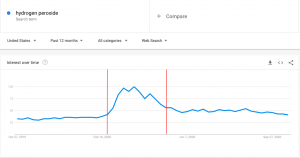
Data, data, data. There’s so much of it around nowadays. There’s data on every aspect of online life. Except perhaps, whether Jon Snow will return in Season 6 of Game of Thrones. So, almost everything.
But just what does this data mean to you, and how can you use it to boost your business? In this article, I will show you how to take some of the social media data out there, and use it to transform your business, starting now.
Here are some social media facts that caught my eye.
Data from Hubspot states that:
Companies that published 16+ blog posts per month got almost 3.5X more traffic than companies that published between 0 – 4 monthly posts.
B2C companies that blogged 11+ times per month got more than 4X as many leads than those that blog only 4 – 5 times per month.
Companies that had published 401+ blog posts in total got about twice as much traffic as companies that published 301 – 400 blog posts.
What does this mean to you and how can you use it to boost your business? Well, this bit of data is pretty straightforward. It states that the more frequently you publish your blog, the more traffic and leads you’ll generate.
So if you’re publishing around 4 times a month, you should maybe think of publishing more often. If your readers complain that they’re getting too many emails, don’t send out an email every time you publish. Instead, switch to a weekly email digest and the complaints and unsubscribes should stop.
If you have a lot of content written already, don’t publish it all at once, just so you cross 401 posts. Instead, schedule it to go out a few times a week and you won’t raise any red flags with Google for content dumping.
Also, don’t just create crappy, me-too content, just so you can have a lot of blog posts out there. Publishing quality content beats having lots of substandard content, because it will generate more social shares – a powerful ranking signal for Google.
As the Hubspot study concludes, “companies that make a commitment to regularly publish quality content to their blogs tend to reap the biggest rewards in terms of website traffic and leads — and those results continue to pay out over time.”
Data from the 2014 Professional Content Consumption Report states that:
The two biggest reasons professionals access content on LinkedIn is to “keep up with industry news” and “discover new ideas within the industry,” at 78% and 73% respectively.
So how can you use this to boost your visibility and connections on LinkedIn? What you need to do is stop posting generic content (eg. 5 Success Tips For Entrepreneurs), unless you’re a business coach, and post more specific content related to your industry, or the industry that your prospects work in.
For example, if you’re targeting industry professionals looking for a workplace redesign, publish more content on workplace strategy and issues related to the workplace. You might get more professionals in the workplace industry interested in an article on, say, open offices or standing desks, than with a more generic topic.
Data from Ion Interactive says that:
Comparing interactive to passive content, interactive content is somewhat of very effective at educating the buyer (93% vs 70%), differentiating from competitors (88% vs 55%) and being shared (38% vs 17%).
Interactive content, such as apps, assessments, calculators, configurators and quizzes, generate conversions moderately or very well 70% of the time, compared to just 36% for passive content.
Here’s a chance for you to get ahead of those pesky competitors that have not yet discovered the benefits of interactive content. Invest a percentage of your content creation and marketing budget in creating more interactive content that will generate interest among your target audience.
For instance, JLL recently unveiled an interactive tool called RED, that “assimilates your real estate data and then integrates it with your business and market data, through a single open platform that plugs directly in to your existing apps.”
The way to set yourself apart from others in the industry is to create something so valuable that your target audience can’t resist using it, which is what JLL has done with RED.
Data from Moz states that:
Blog posts incorporating video attract 3x as many inbound links as blog posts without video.
Posts with all three media types (videos, images, and lists) will attract almost 6 times more inbound links than a plain text post.
Posts with between 1800 and 3000 words will attract more than 15 times more inbound links than a post with less than 600 words.
This data tells you that you need to incorporate more visual elements into your blog posts. You must always have an image designed to look good when it is pulled into Facebook or Twitter’s newsfeed. Make sure you install an Open Graph plugin that pulls in the right image from your blog.
Add a video to your post and more people will want to link to it. Certain post formats – like list posts – will automatically get more links than others. The takeaway from this is that while you shouldn’t make every post a list post, you should definitely write more of them.
Also make your posts longer and more comprehensive than other posts in its category. Use Brian Dean’s Skyscraper Technique to really make your posts stand out from the clutter and build quality inbound links as well.
Data from MarketingSherpa states that:
60% of marketers report a positive ROI from email marketing.
How can you use this data to help your business succeed? Well, for starters, start building a mailing list, if you haven’t done so already. Offer a free giveaway, discount coupon or other incentive to get blog readers to subscribe to your list.
If you run an ecommerce site, you should send more post-purchase follow-ups, re-engagements, shopping cart abandonment reminders. Implement a robust email marketing solution and focus more of your efforts on email marketing.
Having a blog and mailing list makes your marketing network neutral and makes you less dependent on social networks for your traffic and sales. Use these tips from Jeff Bullas to integrate your social media and email marketing efforts.
Data from Buffer states that:
Tweets with images received 18% more clicks, 89% more favourites and 150% more Retweets than tweets without images.
So how do you use this data to boost your own Twitter engagement? First, you need to post an appropriate and attractive image with every tweet.
Second, when tweeting links from your blog, make sure that you have a plugin installed that adds the Twitter Cards meta tags, so that Twitter can pull in the image from your blog posts and display them in the newsfeed. I like to use the Twitter Cards Meta plugin for this purpose.
Buffer also has data stating that you should share your post more than once on Twitter.
To me, this means that you should also repost your evergreen content to Twitter, using a plugin called Revive Old Post. This will help you give your evergreen content a new least of life, boosting engagement as well as traffic.
Whenever you see new data on social media, think about how you can use those statistics to your advantage, to take your business goals up a notch and elevate your social media marketing efforts.
(195)




